Lakes in, or bordered by, Chad include:
- Lake Chad
- Lake Fianga
- Lake Fitri
- Lake Iro
- Lake Katam
- Tibesti Soda Lake
- Lake Yoa
- Lake Tréné
- Léré Lake
Lakes in, or bordered by, Chad include:
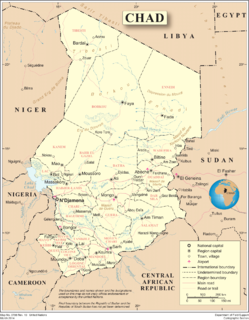
Chad is one of the 47 landlocked countries in the world and is located in North Central Africa, measuring 1,284,000 square kilometers (495,755 sq mi), nearly twice the size of France and slightly more than three times the size of California. Most of its ethnically and linguistically diverse population lives in the south, with densities ranging from 54 persons per square kilometer in the Logone River basin to 0.1 persons in the northern B.E.T. (Borkou-Ennedi-Tibesti) desert region, which itself is larger than France. The capital city of N'Djaména, situated at the confluence of the Chari and Logone Rivers, is cosmopolitan in nature, with a current population in excess of 700,000 people.

Chad, officially the Republic of Chad, is a landlocked country at the crossroads of North and Central Africa. It is bordered by Libya to the north, Sudan to the east, the Central African Republic to the south, Cameroon to the southwest, Nigeria to the southwest, and Niger to the west. Chad has a population of 16 million, of which 1.6 million live in the capital and largest city of N'Djamena.
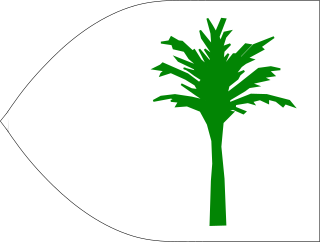
The Kanem–Bornu Empire existed in areas which are now part of Niger, Cameroon, Central African Republic, Chad, and Nigeria. It was known to the Arabian geographers as the Kanem Empire from the 8th century AD onward and lasted as the independent kingdom of Bornu until 1900.

Lake Chad is a historically large, shallow, endorheic lake in Central Africa, which has varied in size over the centuries. According to the Global Resource Information Database of the United Nations Environment Programme, it shrank by as much as 95% from about 1963 to 1998. The lowest area was in 1986, at 279 km2 (108 sq mi), but "the 2007 (satellite) image shows significant improvement over previous years." Lake Chad is economically important, providing water to more than 30 million people living in the four countries surrounding it on the central part of the Sahel. It is the largest lake in the Chad Basin.
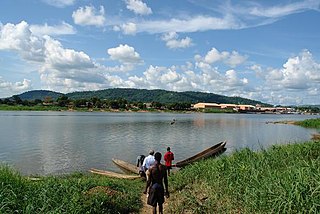
The Ubangi River, also spelled Oubangui, is the largest right-bank tributary of the Congo River in the region of Central Africa. It begins at the confluence of the Mbomou and Uele Rivers and flows west, forming the border between Central African Republic (CAR) and Democratic Republic of the Congo. Subsequently, the Ubangi bends to the southwest and passes through Bangui, the capital of the CAR, after which it flows south – forming the border between Democratic Republic of the Congo and Republic of the Congo. The Ubangi finally joins the Congo River at Liranga.

Central Africa is a subregion of the African continent comprising various countries according to different definitions. Angola, Burundi, Cameroon, the Central African Republic, Chad, the Democratic Republic of the Congo, the Republic of the Congo, Equatorial Guinea, Gabon, Rwanda, and São Tomé and Príncipe are members of the Economic Community of Central African States (ECCAS). Six of those states are also members of the Economic and Monetary Community of Central Africa (CEMAC) and share a common currency, the Central African CFA franc.
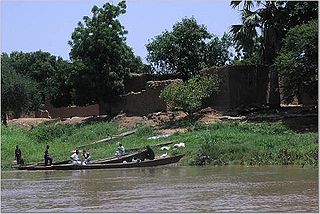
The Chari River, or Shari River, is a 1,400 kilometres (870 mi) long river, flowing in Central Africa. It is Lake Chad's main source of water.

N'guigmi is a city and Commune of fifteen thousand in the easternmost part of Niger, very near to Lake Chad – lying on its shore until the lake retreated. It is a crossroads for the traditional camel caravans of the Toureg and for traders plying North and South across the Sahara.
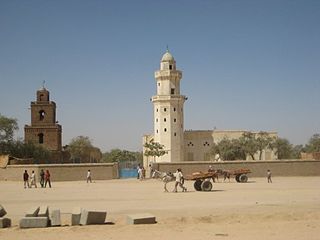
The earliest presence of Islam in Chad can be traced back to Uqba ibn Nafi, whose descendants can be found settled in the Lake Chad region to this day. By the time Arab migrants began arriving from the east in the fourteenth century in sizeable numbers, the creed was already well established. Islamization in Chad was gradual, the effect of the slow spread of Islamic civilization beyond its political frontiers. Among Chadian Muslims, 48% professed to be Sunni, 21% Shia, 23% just Muslim and 4% Other.

Chad Randall Barrett is an American former professional soccer player who played as a forward.

The Far North Region, also known as the Extreme North Region, is the northernmost constituent province of the Republic of Cameroon. It borders the North Region to the south, Chad to the east, and Nigeria to the west. The capital is Maroua.
The Buduma are an ethnic group of Chad, Cameroon, and Nigeria who inhabit many of the islands of Lake Chad. They are predominantly fishers and cattle-herders. In the past, the Buduma carried out violent raids on the cattle herds of their neighbors. They were feared villains with aggressive reputations; thus, they were respected and left alone for many years, protected by their own habitat of water and reeds.

The wildlife of Chad is composed of its flora and fauna. Bush elephants, West African lions, buffalo, hippopotamuses, Kordofan giraffes, antelopes, African leopards, cheetahs, hyenas, and many species of snakes are found there, although most large carnivore populations have been drastically reduced since the early 20th century. Elephant poaching, particularly in the south of the country in areas such as Zakouma National Park, is a severe problem.

Chadian Arabic, also known as Shuwa Arabic, Baggara Arabic, Western Sudanic Arabic, or West Sudanic Arabic (WSA), is a variety of Arabic and the first language of 1.6 million people, both town dwellers and nomadic cattle herders. The majority of its speakers live in southern Chad. Its range is an east-to-west oval in the Sahel. Nearly all of this territory is within Chad or Sudan. It is also spoken elsewhere in the vicinity of Lake Chad in the countries of Cameroon, Nigeria, Niger. Finally, it is spoken in slivers of the Central African Republic, and South Sudan. In addition, this language serves as a lingua franca in much of the region. In most of its range, it is one of several local languages and often not among the major ones.
Yedina, also known as Buduma (Boudouma), is a Chadic language of the Biu–Mandara branch spoken around Lake Chad in western Chad and neighbouring Cameroon and Nigeria.
Ouaddaï Highlands is an area in east of Chad along the border with Sudan. The Ennedi Plateau and the Ouaddaï highlands in the east of Chad complete the image of a gradually sloping basin, which descends towards Lake Chad. There are also central highlands in the Guera region rising to 1,500 m (4,921 ft).
The Yaéré, from Fula yaayre, is the name of a vast annually-flooded grassland and savanna, part of the extensive floodplains around the shallow and variable Lake Chad in Central Africa. The Yaéré is part of the Lake Chad flooded savanna ecoregion.
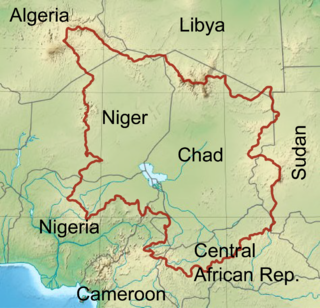
The Chad Basin is the largest endorheic basin in Africa, centered on Lake Chad. It has no outlet to the sea and contains large areas of semi-arid desert and savanna. The drainage basin is roughly coterminous with the sedimentary basin of the same name, but extends further to the northeast and east. The basin spans eight countries, including most of Chad and a large part of Niger. The region has an ethnically diverse population of about 30 million people as of 2011, growing rapidly.
The Lake Chad attack was a terrorist attack on the Niger side of Lake Chad by 30 members of Boko Haram, an Islamic sect in northeastern Nigeria.
The December 2015 Chad suicide bombings occurred on 5 December 2015 when four suicide bombers at Lake Chad kill at least 15 people and another 130 were injured. Four women carried out the attack at a weekly market on an island on the Chadian side of the lake. No group has claimed responsibility; officials suspect the attacks were carried out by members of the Boko Haram militant group from neighboring Nigeria.